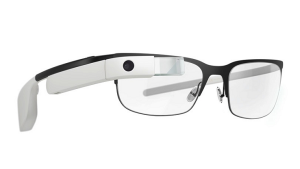After a few years of prototype and developer version, Google finally released its retail version Google Glass. In this review, a high level overview of Google glass is introduced, and then followed by testing Google glass in the
university environment. Google glass has invoked a lot of interest in different research area, some of the particular research projects are also discussed in the review.
Google glass is a type of wearable technology with an optical head-mounted display (OHMD). It claims to be the world’s first fully functional wearable computer with Glass. Users wear Google Glass as wearing a pair of glasses,
with the OHMD projects a display in front of user’s eyes. It comes with the main system on Chip TI OMAP4430 Dual 1.2GHz (ARMv7), 2GB RAM, 16GB of storage, an InvenSense MPU-9150 (gyroscope, accelerometer and compass) and a Wolfson WM7231 MEMS microphone and a 5-megapixels camera. The Bone Conduction Speaker next to the battery transmits audio by conduction through to the inner ear. Google glass runs Android 4.4 KitKat but the interface has been customized for Google Glass. It support Wifi 802.11 b/g and Bluetooth 4.0 LE but doesn’t have a GPS sensor or any 3G/4G SIM card slot.

Google glass is very light; the bare device is just 36grams which is the same weight category as a regular pair of glasses. Interaction with the Glass is mainly through two primary means: voice activated commands and the
Touchpad that runs along the right hand side of the frame. Glass is wakened by tilting your head backwards or tapping the right side of the frame (the display sleeps after just 15 seconds of inactivity). Google also launched an app called MyGlass for both Android and iOS to go with the Glass. The MyGlass app enables users to configure and manage Google Glass.
